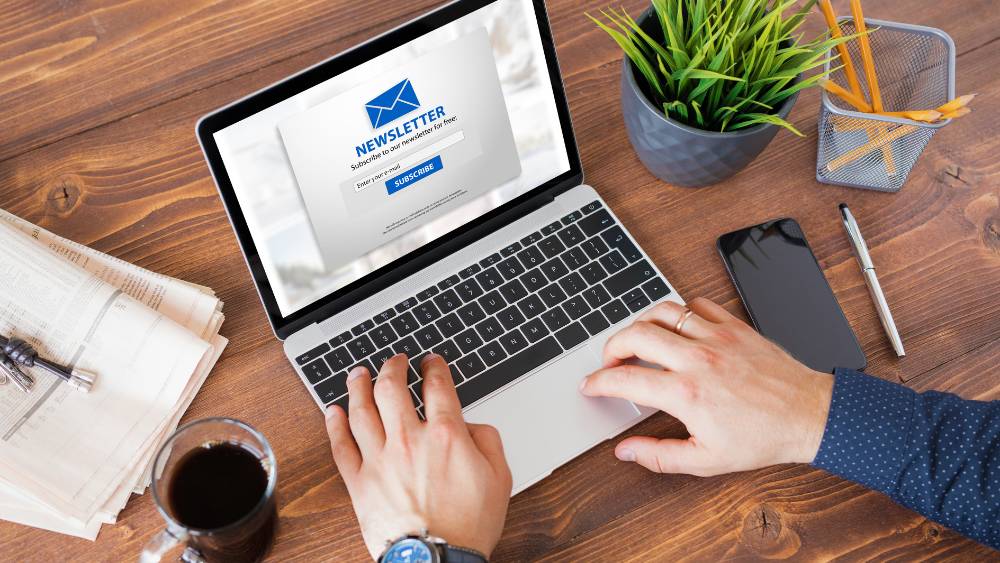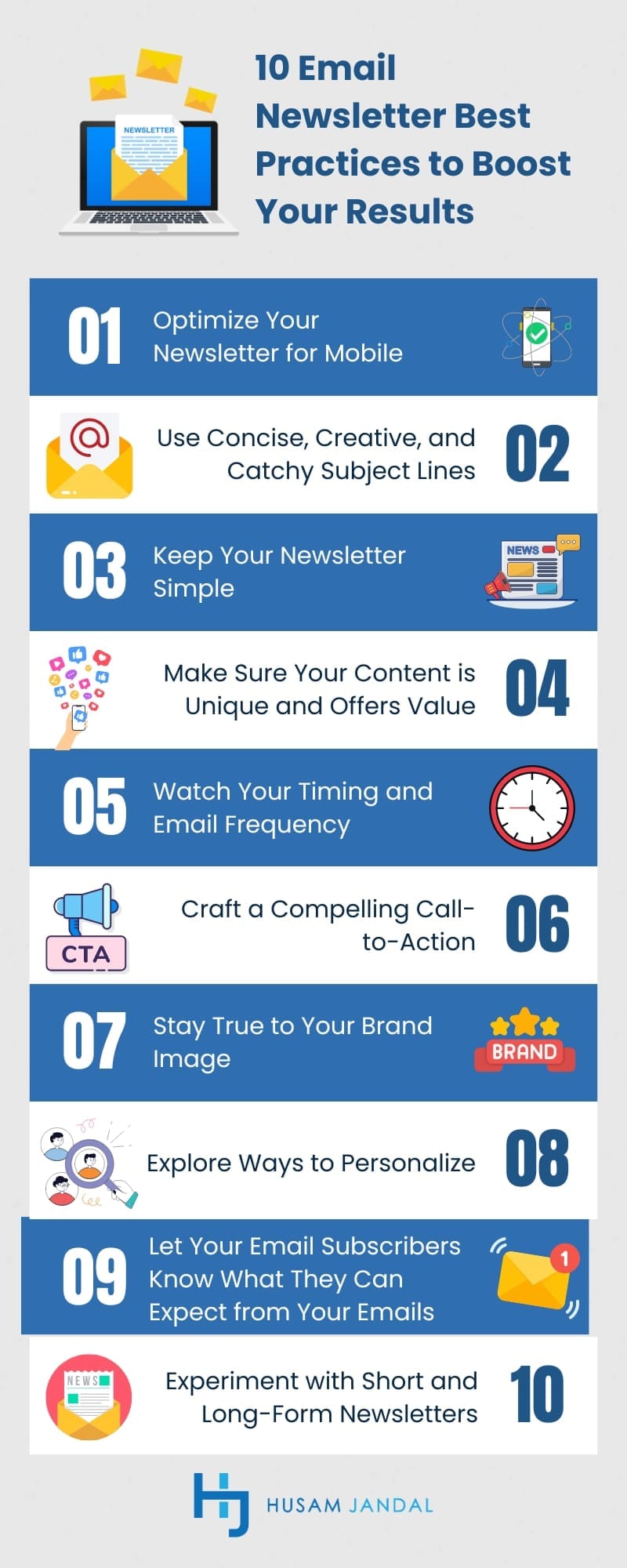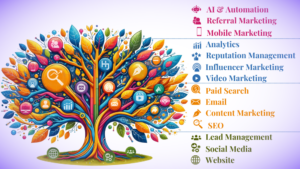
If you want to improve your overall email marketing strategy, sending newsletters is a great place to start. Nearly 80 percent of B2B companies say email is the most successful channel for content distribution, and more than three-quarters leverage e-newsletters as part of their content marketing efforts, according to OptinMonster. But, if you aren’t leveraging email newsletter best practices, it’s easy to feel like you’re just spinning your wheels and never seeing real results.
On this page, I’ll go over the basics of how to write an email newsletter, what to include in your newsletters, tips to increase opens and clicks, and examples you can use to improve your email marketing strategy.
What Can a Good Email Newsletter Do for Your Business?
When you’re following email marketing best practices and giving your readers rich content that they can’t find anywhere else, you’ll also:
- Get more mileage from your content. You can share and reshare quality evergreen content endlessly, which means your creation costs reduce and your return on marketing investment (ROMI) increases.
- Build brand recognition, relationships, and loyalty. The more positive experiences a person has with your brand, the closer they’ll feel to you.
- Give customers and prospects a breather. Nobody likes to be sold to all the time. Your email newsletters give them something of value without having to purchase anything.
- Gain insights into your audience. The more you send, the easier it becomes to identify what resonates with your audience, so you can create more content they’ll love. You can also send polls to get direct feedback.
- Improve deliverability and the success of other email campaigns. When people don’t open your emails, your messages can start to look like spam to email providers. Rather than landing in inboxes, your emails land in spam folders, and the recipients don’t see them. This is known as an email deliverability issue. Because people are more likely to engage with helpful, non-sales content, your overall opens and clicks get a boost, and your emails are more likely to go where you want them to – the inbox.
- Increase website traffic. Email newsletters typically direct people back to your website, where they engage with more content and take actions like requesting consultations and making purchases.
- Boost revenue and profitability. All these things combined can dramatically impact your sales, improve your ROMI even more, and help make your business more profitable.
What Should You Include in Your Newsletters?
Email newsletters should keep audiences in the know and focus primarily on non-sales content. A few newsletter ideas include:
- Blog Posts/ Articles
- How-To Guides
- Tips
- Video Content
- Webinars and Events
- Company News
- Industry News
- Testimonials
- User-Generated Content
- Polls
- Promotions
- Contests and Giveaways
10 Email Newsletter Best Practices to Boost Your Results

Now that we’ve gone over the benefit of email marketing and what to include, let’s explore some email newsletter marketing tips that will increase your opens and clicks.
1. Optimize Your Newsletter for Mobile
Nearly 42 percent of emails are opened on mobile devices, according to Litmus. So to meet the needs of your readers, your newsletters must be mobile-friendly. This includes things like:
- Using larger font sizes.
- Having a single-column layout or a layout that stacks columns (and still looks great) on mobile.
- Making clickable elements larger and leaving ample space between them.
2. Use Concise, Creative, and Catchy Subject Lines
Email clients designed for desktop users allow the reader to see about 60 characters in the subject line, while email clients on mobile devices cap off at 25-30 characters. Anything included after that point is cut off, and your readers won’t see it. Depending on the structure of your subject line, it may be difficult or impossible to gauge your message if you’re overly wordy. That’s not good for the reader experience and can kill your open rates.
Lead with the most important information and keep your subject lines as concise as possible to avoid the issue. Try to pique their curiosity while staying true to your brand and tone. About a third of people open emails purely because the subject line is catchy, according to OptinMonster. Some businesses can use humor, while others lead with a tip or some insight about what they’ll find inside.
Listed below are some examples of email subject lines:
- “5 Things Effective Leaders Do Before 10 am”
- “Top 10 Reasons Your Leads Ghost You”
- “Why Your Team is Quietly Quitting”
- “How to Double Your Open Rate Overnight”
3. Keep Your Newsletter Simple
A newsletter aims to draw readers to your other digital properties, so any content you include should be as concise and compelling as possible. Images are important for engagement, too but stick to the 60/40 rule: have at least 60 percent text and no more than 40 percent images. As I mentioned in “Email Marketing Deliverability – The Shocking Challenges!” this is one factor determining whether your newsletter lands in an inbox or gets caught in a spam filter too.
4. Make Sure Your Content is Unique and Offers Value
People subscribe to newsletters to get unique and exclusive content from you. They’ll unsubscribe or stop opening if you don’t deliver on that expectation. Ensure they receive value by sending helpful or educational content such as:
- Insider information
- Exclusive offers
- Free giveaways
- Polls (especially if they’re voting on something that shapes the products or services they use)
5. Watch Your Timing and Email Frequency
It may take time to nail down the best email marketing schedule for your audience. For example, some businesses do weekly or biweekly newsletters, while others send monthly. Take polls to see what your readers prefer, or allow them to select their preferred interval and segment based on their preferences. Alternatively, you can also run tests to identify the sweet spot with mailings.
Once you have the frequency down, create a schedule and stick to it. For example, mail on the same day at the same time every time. This makes planning easier for you and shows readers that your organization is dependable. Plus, your readers will learn when to expect your communications and will start to look for them in their inboxes, which does wonders for open and click-through rates.
6. Craft a Compelling Call-to-Action
While email newsletters are great for boosting engagement in their own right, the ultimate goal is to get your reader to take a specific action. The intent varies. You may want them to read content, download something, request a quote, or something else. Whatever the primary draw is, always make sure that call-to-action stands out more than anything else in the newsletter and draws eyes to it. Experiment with different phrases to see which ones work best. For example:
- Learn More
- Download Instantly
- Get Your Free Kit
- Register Free
- Watch Now
- See How It Works
7. Stay True to Your Brand Image
Good branding is about more than matching your color scheme and adding your logo. The voice used in your newsletter should match the voice on your website, on social media, and everywhere else. A consistent email marketing campaign will make your brand more recognizable and encourage familiarity, which will lead to better relationships.
8. Explore Ways to Personalize
Most people who engage in email marketing have probably heard that adding the email recipient’s name to the subject line or preview text increases open rates. There are even studies that show open rates jump by 37 percent (19.4 percent with personalization vs. 15.4 percent without), according to Experian. The problem is that this bit of “conventional wisdom” doesn’t ring true in every situation. For example, a 15 percent open rate decline (18.79 percent with personalization vs. 22.14 percent without) was noted by MarTech.
This highlights the importance of A/B testing. Your audience may or may not respond to name personalization. Try it a few times to see if it improves your open rates. In separate tests, experiment with personalizing the subject line, preview text, and internal copy. Make note of any differences in opens and clicks.
Also, consider the types of content you’re sending your readers. Segment your lists based on interests, industry, role, and other traits. Then, try to send each list a newsletter that’s designed to meet their specific needs.
9. Let Your Email Subscribers Know What They Can Expect from Your Emails
Your newsletter signup page should explain what you share in your newsletter and how often subscribers can expect to hear from you. Whenever possible, give them the option to view your latest newsletter so that they can explore the fit.
10. Experiment with Short and Long-Form Newsletters
Many people think of a newsletter as a directory of the latest content. For example, you might showcase four recent blogs, each with a nice image, a brief description, and a call to action. However, that’s only one approach to newsletters. Sometimes readers respond better to a personal note with minimal images, a longer intro into a piece, or a quick recap of a piece. Try different angles to see what gets the most engagement from your audience.
Get Help Mastering Email Newsletter Best Practices
If you’re not getting the results you want from your email marketing campaign, you’re struggling to bring consistency to your channels, or you feel your digital marketing isn’t performing as well as it should, let’s chat. As a digital marketing consultant with experience helping Fortune 100 brands reach new heights, I firmly believe that every business can scale through effective digital marketing and welcome the opportunity to learn more about your company. Please contact me for a complimentary consultation.





































































